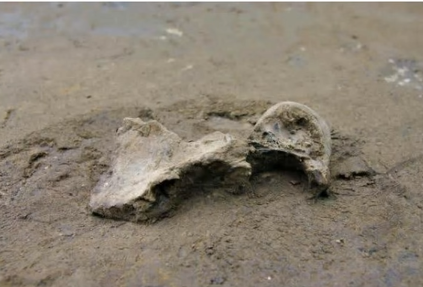By Angel Lee, | April 16, 2017

This discovery of the European saber-toothed cat is one of the best-documented finds of the species. (YouTube)
Scientists have found 11 fragments of a saber-toothed cat's skull in Germany.
The saber-toothed cat is believed to have gone extinct about 200,000 years ago. These big cats lived about 500,000 years ago with long claws, razor sharp teeth and were about the size of a fully-grown lion. The saber-toothed cat, known scientifically as the Homotherium latidens, was a dangerous predator that posed a threat to humans and other animals.
Like Us on Facebook
On May 2015, the excavation team from the university of Tűbingen came across the bone fragments. Scientists found 11 fragments of the saber-toothed cat's skull in sediment layers.
The European saber-toothed cat (Homotherium latidens) is a very rare carnivore species. They found several teeth and one humerus fragment. Scientists have assembled the bone structure and found that the interior skull reflects the shape of the cat's brain. The scientist then conducted an examination to gain more insight about the hearing and visual abilities of the saber-toothed cat as well as its feeding habits
This discovery of the European saber-toothed cat is one of the best-documented finds of the species. The presence of this species may have been dated back to the Middle Pleistocene age were they had an impact on the lives of hominins. This discovery also sheds light on the day-to-day challenges of European hominins who possibly created wooden spears not only for hunting purposes but also for self-defense.
-
Use of Coronavirus Pandemic Drones Raises Privacy Concerns: Drones Spread Fear, Local Officials Say

-
Coronavirus Hampers The Delivery Of Lockheed Martin F-35 Stealth Fighters For 2020

-
Instagram Speeds Up Plans to Add Account Memorialization Feature Due to COVID-19 Deaths

-
NASA: Perseverance Plans to Bring 'Mars Rock' to Earth in 2031

-
600 Dead And 3,000 In The Hospital as Iranians Believed Drinking High-Concentrations of Alcohol Can Cure The Coronavirus

-
600 Dead And 3,000 In The Hospital as Iranians Believed Drinking High-Concentrations of Alcohol Can Cure The Coronavirus

-
COVID-19: Doctors, Nurses Use Virtual Reality to Learn New Skills in Treating Coronavirus Patients










